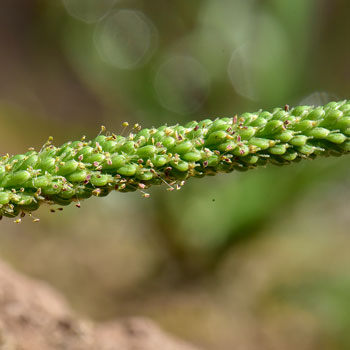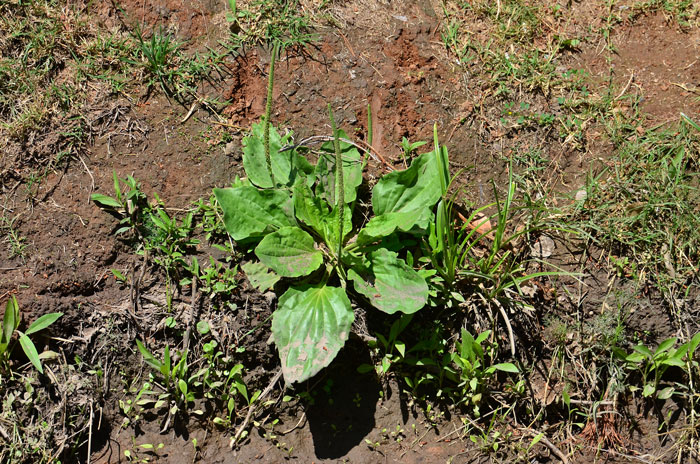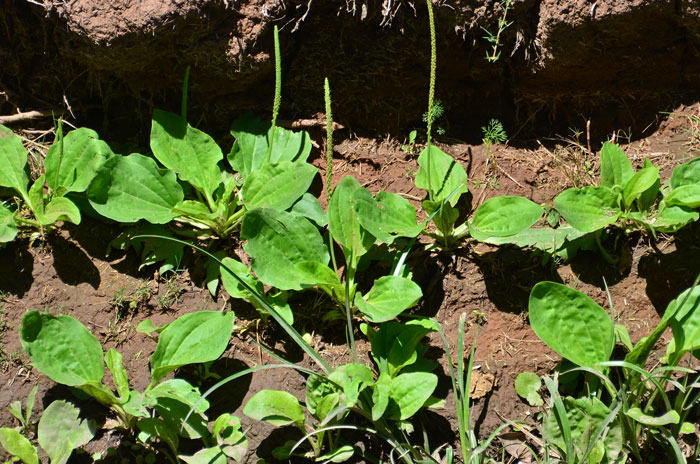Plantago major, Common Plantain




Scientific Name: Plantago major
Common Name: Common Plantain
Also Called: Broadleaf Plantain, Buckhorn Plantain, Rippleseed Plantain
Family: Plantaginaceae or Plantain Family
Synonyms: (Plantago asiatica, Plantago halophila, Plantago intermedia, Plantago major subsp. intermedia, Plantago major var. asiatica, Plantago major var. intermedia, Plantago major var. pachyphylla, Plantago major var. pilgeri, Plantago major var. scopulorum)
Status: Introduced
Duration: Perennial
Size: Up to 12 inches more or less.
Growth Form: Forb/herb; mostly glabrous except for the peduncle (see photograph above), fibrous roots.
Leaves: Green; ribbed basal leaves, leaves large, up to 7 inches more or less, shape variable broadly ovate or elliptical, leaf surface rough, leaf margin mostly entire.
Flower Color: Green; inflorescence a long spike (see photograph above); fruit a circumscissile capsule.
Flowering Season: March to October; April to September in California; June to October in Texas.
Elevation: 1,000 to 7,000 feet.
Habitat Preferences: Moist soils along streams; native to Europe.
Recorded Range: Common Plantain is found throughout all parts of North America. It is also established in Baja California and Mexico.
It is found throughout most of Arizona in shady, moist or damp areas (few or no records for Pinal County).
North America & US County Distribution Map for Plantago major.
U.S. Weed Information: In North America Plantago major is listed in: Weeds of the Northeast and Weeds of the West. Plants included here may become weedy or invasive.
Invasive/Noxious Weed Information: No information available.
Wetland Indicator: In North America Plantago major has the following wetland designations: Alaska, FACFACUFACW; Arid West, FAC; Atlantic and Gulf Coastal Plain, FAC; Eastern Mountains and Piedmont, FACU; Great Plains, FAC; Midwest, FAC; Northcentral & Northeast, FACU; Western Mountains, Valleys, and Coast, FAC.
FAC = Facultative, occur in wetlands and non-wetlands
FACU = Facultative Upland, usually occur in non-wetlands, but may occur in wetlands
FACW = Facultative Wetland, usually occur in wetlands, but may occur in non-wetlands.
Threatened/Endangered Information: No information available.
Genus Information: There are 35 species in Plantago in North America (49 accepted taxa overall).
There are approximately 12 species in Plantago in Arizona and New Mexico; 17 species in California and 15 species in Texas.
Comments: Common Plantain is found throughout all parts of North America where it is naturalized from Europe. Not a showy plant and often regarded as a weed.
In Southwest Desert Flora also see Desert Indianwheat, Plantago ovata and Woolly Plantain, Plantago patagonica.
Plantago major has been used by the Abnaki as a analgesic drug (poultice of leave applied for pain and as an external anti rheumatic (poultice of leaves applied to the foot for rheumatism or swellings and by the Algonquin as a burn dressing (poultice of leaves applied to burns. See ethno-botanical uses at Native American Ethnobotany, University of Michigan, Dearborn.

